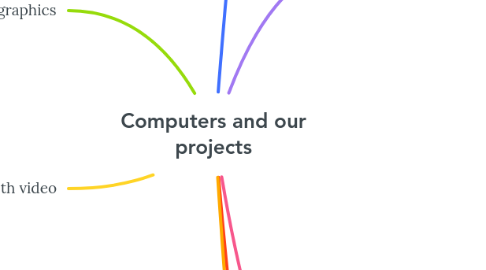
1. 6. Infographics
1.1. Lets us combine images, text and multimedia. We can make an infographics online application.
1.1.1. Canva
1.1.2. Gimp
2. 7. Working with video
2.1. Videos editors allow us to.
2.1.1. Combine images to create a video.
2.1.2. Edit video sequences.
2.1.3. Add audio tracks.
2.1.4. Add titles and text.
2.2. OpenShot
2.2.1. Is a free, open-source video editor that works with Linux and Windows
2.3. Kdenlive
2.3.1. Similar to OpenShot, but it is more complex to use.
3. 1. Hadware and Software
3.1. Hadware and Software: Peripheral devices (input and output), Data store devices, Central processing unit.
3.2. The motherboard and peripheral devices.
3.3. Connecting peripheral devices
3.4. Phisical connection
3.4.1. Expasion ports
3.4.2. SATAconectors
3.4.3. Input and output ports
3.5. Control program and driver
4. 2. The operation systems
4.1. Software licences
4.1.1. Free software
4.1.2. Propietary software
4.2. Types of software
4.2.1. Operating systems
4.2.2. Applications
4.2.3. Programming languages
4.3. The functions of an operation system
4.3.1. To manage the microprocessor;
4.3.2. To manage the memory and the storage systems;
4.3.3. To provide an interface for users to use to operate the computer;
4.3.4. To make it possible for applications to communciate with peripheral devices.
4.3.5. It makes regular backup copies.
4.3.5.1. Backup: a second version of something.
4.3.6. It can install and run antivirus programs.
4.3.7. It can delete programs we don't use.
4.3.8. It configures programs so that they open when we turn the computer on.
4.3.9. It keeps the desktop clean and organised.
4.3.10. It clears space on the hard disk.
4.3.11. It checks and clears the recycle bin.
4.3.12. It defragments the hard disk.
5. 3. Installing and uninstalling software
5.1. The installation process depends on which operating system we are using. We also check the system requirements and the licence agreement.
5.1.1. In Windows, we can install software from CD/DVD or we can download it from Internet. When we want to uninstall an application, we do this by using the Control Panel.
5.1.2. In Linux, there are programs called packet managers that facilitate the installation and uninstallation of software. The applications download from Internet and installed automatically.
5.2. Installing and uninstalling software on mobile devices
5.2.1. To install mobile applications (apps), we must access the software repository for our device's operating system.
5.2.1.1. For Android devices, the repository is Google Play
5.2.1.2. For Apple iOS devices, the repository is the App Store
6. 4. Spreadsheets
6.1. A program that lets us store, calculate and compare numerical data.
6.1.1. Basic Operations
6.1.1.1. AVERAGE
6.1.1.1.1. Calculates the average value of cell C2, C3, D2 and D3.
6.1.1.2. SUM
6.1.1.2.1. Adds up the values in column A, rows 1 to 12.
6.1.1.3. MAX
6.1.1.3.1. Shows the highest value in row 1, columns A to E
6.1.1.4. MIN
6.1.1.4.1. Shows the lowest value in row 1, columns A to E.
6.1.2. Charts and graphs
6.1.2.1. We can use a chart wizard to present data from a spreadsheet.
6.1.3. Uses for a spreadsheet
